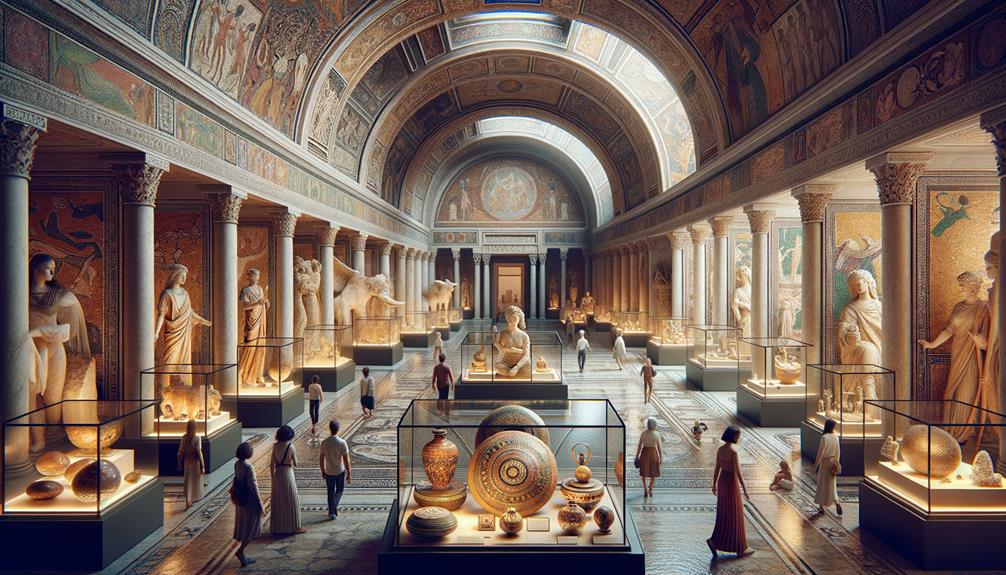A lot of people don't realize just how impressive the Taranto Archaeological Museum (MARTA) is. It holds one of the best collections of ancient Greek artifacts you can find outside Greece. Walking through its halls, I was blown away by the Ori of Taranto, a collection of gold jewelry that's incredibly detailed. The Greek Polychrome Pottery section, with its beautifully decorated vases, shows what daily life and art were like in ancient Taranto. Each artifact tells a story, waiting for anyone curious enough to learn more.
History of MARTA
How did MARTA, the Taranto Archaeological Museum, grow into such a rich repository of ancient history and culture? It all started with a deep passion for preserving Taranto's heritage. This national museum has been carefully curated to display artifacts from the Palaeolithic era, around 1.6 million years ago, to the vibrant Magna-Greek period. Walking through its halls, you can truly feel the weight of history.
The museum's collection mirrors the city's storied past. In the Neolithic section, pottery with Serra d'Alto style geometric and spiral motifs captures the artistic flair of our ancestors. As you move through the archaic and Magna-Greek sections, you'll find ceramic grave goods, everyday items, and Paro marble statues, each telling stories of life in the 8th and 7th centuries BC.
The Ori di Taranto section really stands out, showcasing the city's goldsmithing skills. The intricate gold objects reflect Taranto's wealth and influence during the Magna Graecia period. MARTA's growth into a national archaeological gem highlights Taranto's enduring legacy.
Key Exhibits to See
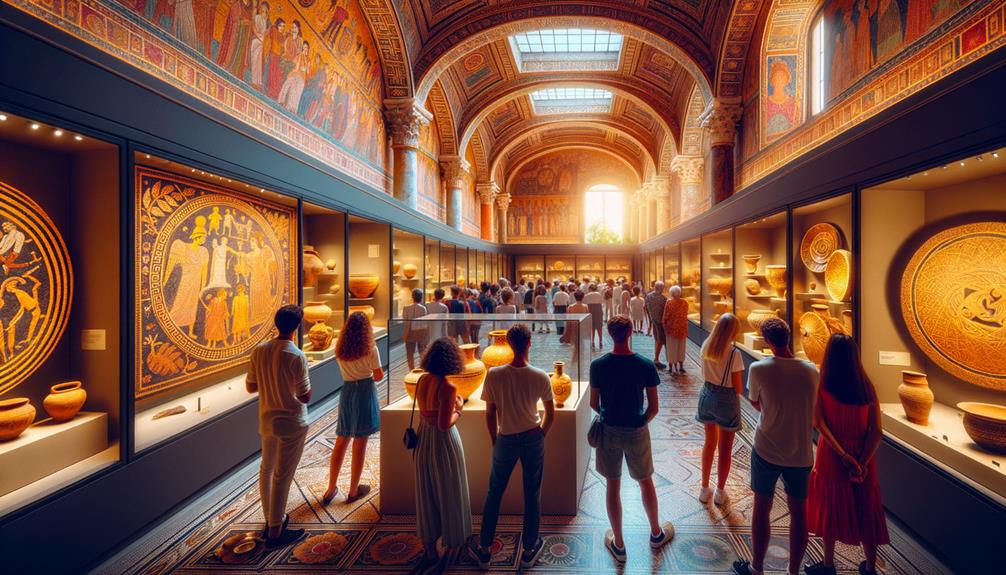
One of the museum's most captivating exhibits is the statue of Thot, shown as a baboon. This piece highlights the detailed craftsmanship and the cultural connections of ancient civilizations. Located in the National Archaeological Museum, it invites visitors to appreciate its artistry and the symbolic role it played in ancient Egypt.
Moving on, the Treasure of the Ori shines with its collection of Hellenistic goldsmith art. The exhibit includes stunning pieces decorated with colored stones and glass pastes, providing a glimpse into the luxurious and refined life of the past.
| Exhibit | Highlights |
|---|---|
| Statue of Thot | Intricate craftsmanship, cultural exchange |
| Treasure of the Ori | Hellenistic goldsmith art, colored stones |
| Greek Polychrome Pottery | Vibrant colors, historical significance |
Another highlight is the Greek polychrome pottery section. The bright colors and intricate designs on these ancient vessels showcase the artistic skill of Greek artisans. Each piece tells a story about daily life, mythology, and traditions of the time.
As I walked through the museum, I reflected on Taranto's rich cultural history. The exhibits not only preserve the past but also celebrate the various influences that have shaped this remarkable city over the years.
Ori of Taranto
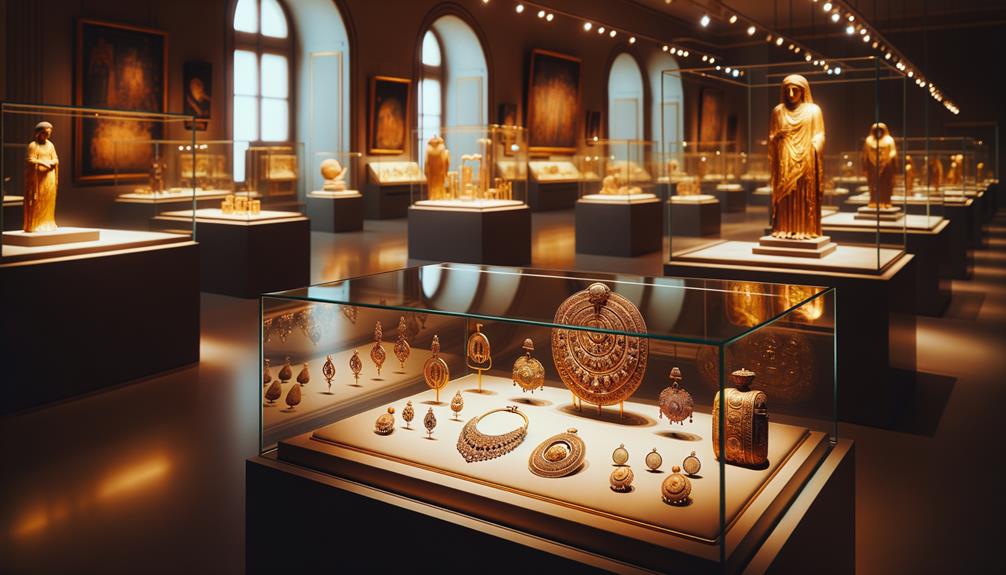
Walking into the Ori of Taranto exhibit, I'm immediately taken aback by the stunning gold artifacts on display. These treasures from the ancient Magna Graecia civilization showcase the remarkable artistry and wealth of that era. Each piece in the collection reflects the height of Hellenistic craftsmanship, telling stories of a time when elegance and sophistication were paramount.
As I move through the exhibit, the intricate filigree work on the necklaces and the delicate engravings on the bracelets catch my eye. The gold gleams softly under the lights, and each artifact seems to whisper tales of ancient nobility and skilled artisans. It's easy to picture the distinguished individuals who once wore these magnificent pieces, strolling through ancient Taranto with pride and grandeur.
The Ori of Taranto is more than just a display of gold artifacts; it's a journey back in time, offering a glimpse into the cultural and artistic achievements of Magna Graecia. It's a testament to the enduring legacy of human creativity and the beauty that comes from it. This exhibit vividly connects history to our present, inviting us to appreciate its tangible links.
Greek Pottery Collection
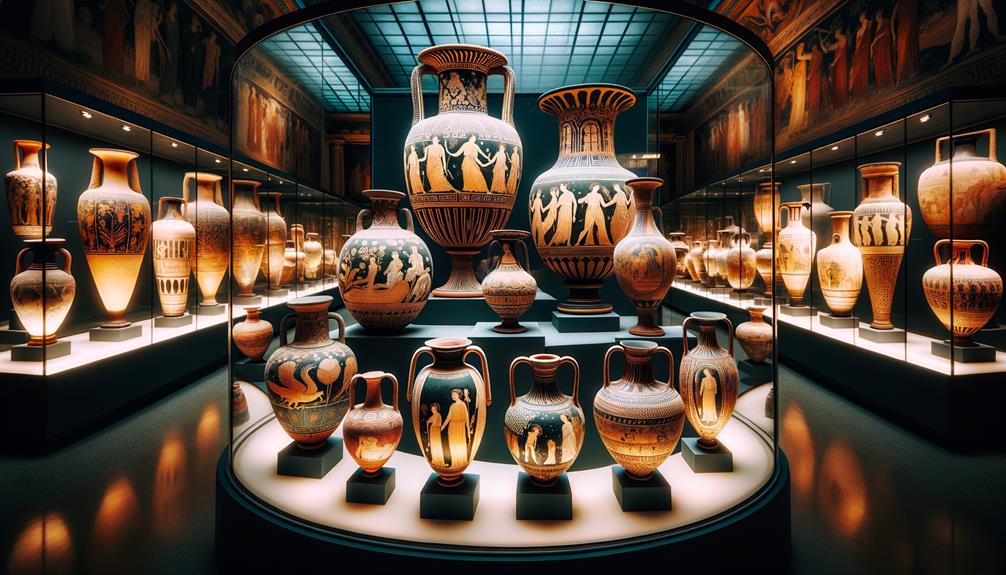
Strolling through the Greek Pottery Collection, I was struck by the detailed vase designs that depict stories of gods, heroes, and everyday life. Each piece offers a window into the historical importance of ancient Greek culture and its artistic development. The museum's careful preservation methods ensure that these ancient ceramics continue to fascinate and educate visitors.
Intricate Vase Designs
While wandering through the Greek Pottery Collection at the Taranto Archaeological Museum, it's easy to be awestruck by the intricate vase designs showcasing the extraordinary craftsmanship of ancient Greek potters. Dating as far back as the 8th century BC, each piece narrates a slice of Taranto's rich history in Italy and demonstrates the evolution of ceramic techniques over the ages.
The vases feature a captivating mix of black-figure, red-figure, and white-ground techniques, each more detailed than the last. One standout is a red-figure krater from the 5th century BC, adorned with vibrant mythological scenes that almost seem to move. Another highlight is a stunning Greek amphora, decorated with mythical creatures and intricate plant designs, once used for storing wine.
To fully appreciate these masterpieces, consider:
- The black-figure technique, which came before the red-figure style.
- The fine details in Attic vases, known for their quality.
- The blend of functionality and art in everyday objects.
- The mythological stories captured in pottery.
- The meticulous craftsmanship evident in every piece.
Visiting Taranto, you aren't just viewing ancient artifacts; you're stepping into a world where art and storytelling seamlessly intertwined centuries ago.
Historical Significance Explained
As I take in the intricate designs of the vases, I can't help but think about the deeper historical significance of the Greek Pottery Collection at the Taranto Archaeological Museum. This collection is more than just art; it's a window into the cultural and social life of ancient Greece. Pieces like the 'Venus of Taranto' and the 'Zeus of Ugento' aren't just beautiful; they're connections to the past, offering clues about funerary practices and daily life from long ago.
Walking through the museum, I'm amazed by how these artifacts, dating back to the 5th and 4th centuries BCE, connect us to a time stretching from pre-history to the Middle Ages. Each red and black figure vase, amphora, krater, and lekythos tells a story of skill and craftsmanship that has lasted for thousands of years. The vessels found in the necropoles of Taranto and its surroundings highlight the region's historical importance in ancient Greece.
The Greek pottery collection at the Archaeological Museum of Taranto is one of Italy's finest, offering a unique look into the rich artistic, cultural, and historical heritage of ancient Greece in southern Italy.
Preservation Techniques Used
The Greek pottery collection at the Taranto Archaeological Museum is kept in excellent condition thanks to various advanced preservation techniques. Walking through the museum, it's clear how much effort goes into protecting these ancient artifacts for future generations. The blend of traditional methods and modern technology is truly impressive.
Here are some of the ways the Museum of Taranto preserves its pottery:
- Controlled Humidity and Temperature: Keeping the environment at 50-60% relative humidity and 18-22°C helps prevent the ceramics from degrading or cracking.
- Laser Cleaning: This technique safely removes dirt and residues from the pottery's surface.
- Acrylic Resin Consolidation: This method stabilizes pottery fragments, preventing them from crumbling.
- Custom-made Boxes with Silica Gel: These boxes help maintain stable humidity levels, protecting the artifacts from sudden environmental changes.
- 3D Scanning and Printing: This technology creates replicas of delicate pieces, allowing for safer handling and display.
The museum also has a rigorous monitoring system that tracks environmental conditions to ensure the best preservation. The attention to detail not only protects the pottery but also helps us connect with the rich history of Taranto. Each piece tells a story, and the museum's dedication to preservation ensures these stories remain vivid and accessible for everyone.
Roman Sculptures
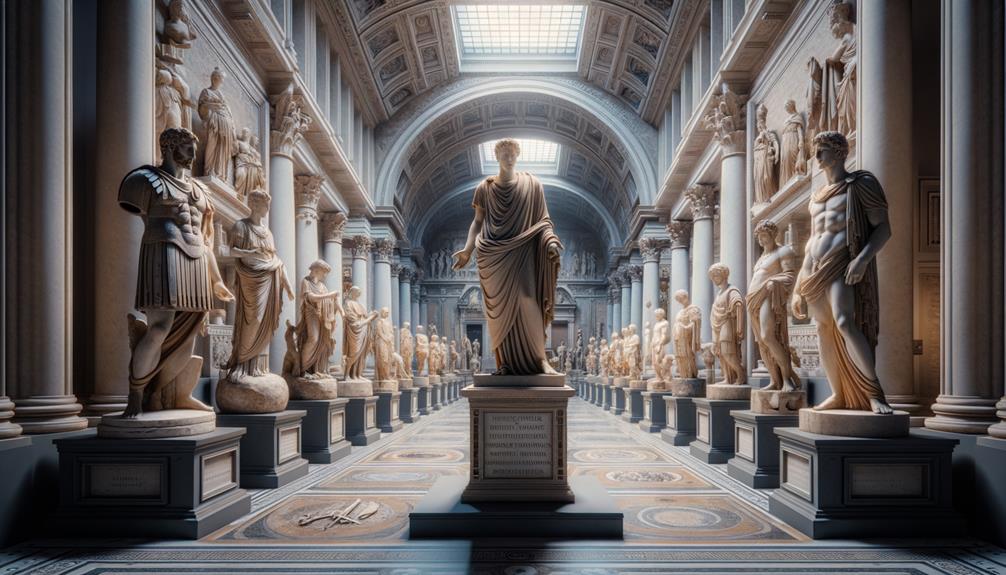
The Roman Sculptures section at the Taranto Archaeological Museum draws visitors in with its stunning marble masterpieces like the Statua di giovane togato and the Statua di Venere, both from the 1st century BC. These impressive pieces give us a glimpse into Roman times, showcasing the incredible talent of their sculptors. The marble sculptures, carefully crafted, highlight the era's dedication to capturing human form and emotion.
As I walked through the exhibits, I couldn't help but be amazed by how these sculptures, once part of Roman homes, show the skillful replication of Greek models. The museum's collection also includes fragments of larger works, like friezes and pediments, which provide valuable insights into Roman funerary practices. Each piece tells a story, revealing the cultural and artistic achievements of the Roman citizens of Taranto.
The sculptural decorations, frescoes, and mosaic floors from Roman homes highlight the luxury and grandeur enjoyed by the Roman elite. This section of the museum offers an immersive experience into the daily lives and refined tastes of ancient Romans, making it a must-visit for anyone interested in their rich heritage.
Visitor Information
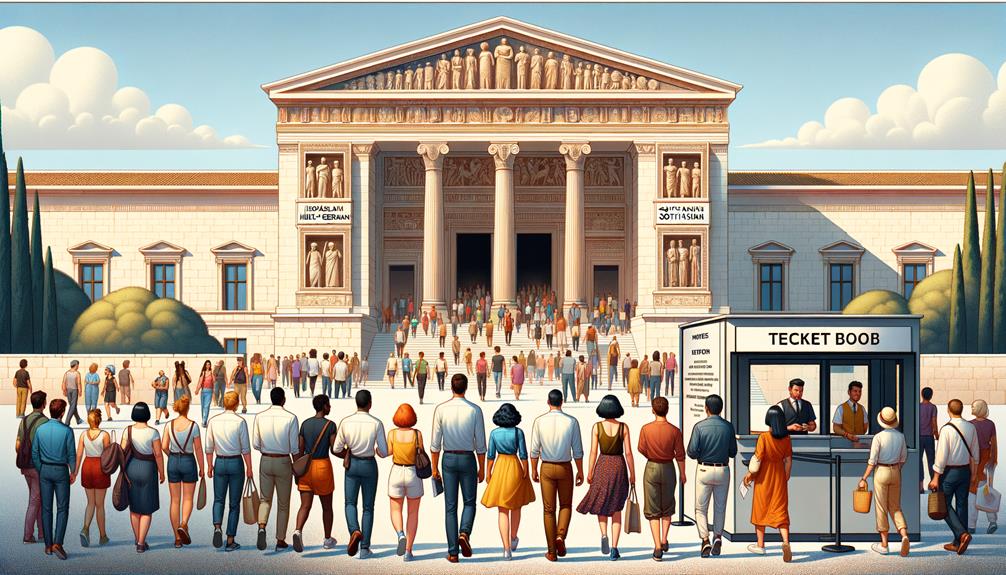
If you're planning a trip to the Taranto Archaeological Museum, it's helpful to know the opening hours and ticket prices in advance. The museum usually opens early, giving you plenty of time to check out its extensive collections. Ticket prices are fair, making it a great option for both solo visitors and families.
Opening Hours Details
Booking your visit to the Taranto Archaeological Museum online is key to having a well-organized experience. When I planned my trip, I quickly saw the benefit of reserving my entry time through the museum's official website. This not only made the process smoother but also helped avoid overcrowding, ensuring a more enjoyable visit for everyone.
To get my ticket, I created an account and shared some basic information, which was easy and secure. While the ticket office does sell tickets on-site when it's not busy, I found the online system to be much more reliable, especially since booking a day in advance is highly recommended. Here are some key points from my experience:
- Online booking is required: Tickets aren't sold at the museum.
- Personal information needed: Necessary for account creation and booking.
- Free entry days: First Sunday of every month.
- Discounts available: For specific age groups and countries.
- Be on time: Punctuality ensures a smooth visit.
In reflecting on my visit, the structured approach to the Taranto Archaeological Museum made my experience more enjoyable and highlighted the museum's commitment to preserving cultural treasures while making sure visitors have a great time.
Ticket Prices Overview
Checking out the ticket prices for the Taranto Archaeological Museum, I found a variety of options to suit different needs and budgets. The Museum of Taranto (MArTA) has a standard ticket that gets you into the permanent collection, which is full of ancient artifacts. If you're into special events, you can buy separate tickets for temporary exhibitions, making your visit more personalized.
What I really liked is how they distinguish between public and private visitors. Students and seniors often get reduced prices or even free entry on certain days, which is a great way to make the museum more accessible. Tourists and general adult visitors have straightforward pricing, so there are no surprises.
There's also a family ticket option, which makes it more affordable for families to explore the museum together. The range of ticket prices shows the museum's effort to respect different financial situations and encourages a diverse crowd to engage with Taranto's rich cultural heritage. This approach highlights the museum's commitment to inclusivity and education.
Special Exhibitions

It's hard not to be amazed by the special exhibitions at the Taranto Archaeological Museum. Each display takes you on a captivating journey through the city's rich history. The 'Treasure of the Ori of Taranto' is a stunning collection of Hellenistic gold artifacts that showcases the city's ancient craftsmanship. These temporary exhibitions, found on the museum's upper floor, delve deep into Taranto's cultural heritage, bringing its traditions and artistry to life.
Walking through these exhibitions, I was struck by the meticulous attention to detail and the rich stories told by each artifact. Past exhibitions like 'The Return of Orpheus and the Sirens' and 'In the Folds of the Toga' highlight unique aspects of history, giving visitors a tangible connection to the past.
To keep things interesting, the museum often pairs these exhibits with guided tours, workshops, and educational programs. This interactive approach ensures that each visit is as enriching as the last. And since the exhibitions are regularly updated, there's always something new to see.
- Treasure of the Ori of Taranto: Hellenistic gold artifacts.
- The Return of Orpheus and the Sirens: Mythological themes.
- In the Folds of the Toga: Roman attire.
- Guided tours: In-depth historical insights.
- Educational programs: Interactive learning experiences.
Contact and Accessibility
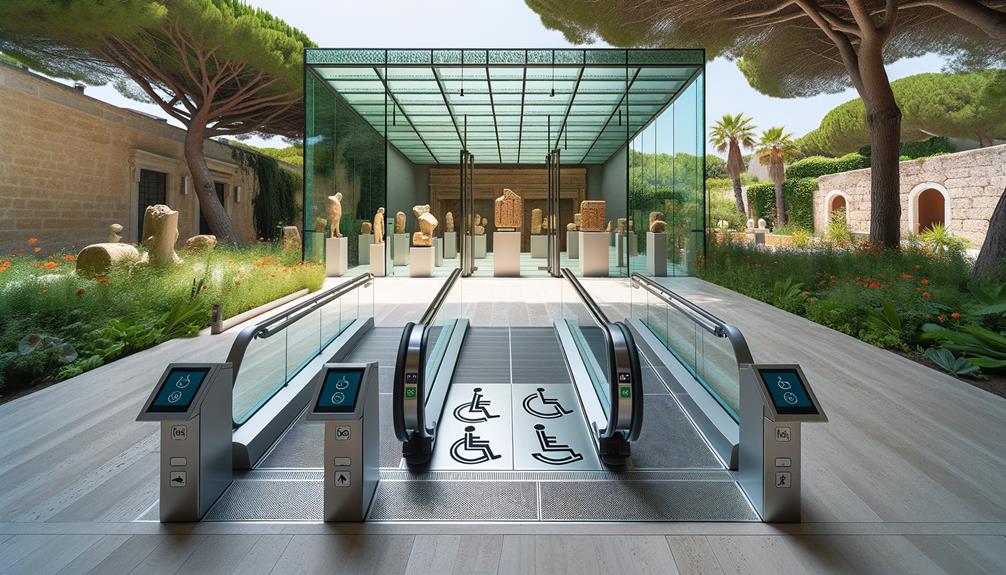
Visiting the Taranto Archaeological Museum is easy, thanks to its central spot in the city. Located in Piazza Garibaldi, MArTA is accessible by foot, local bus, or car, making it a breeze to get there.
The museum's commitment to accessibility is clear. The entrance is designed to accommodate everyone, including those with mobility challenges. With elevators and ramps, navigating the museum's extensive collections is smooth and enjoyable. It's great to see how MArTA ensures that everyone can explore its rich history.
Getting in touch with the museum is just as straightforward. Their official website has all the details you need, and their helpful staff is ready to assist with any questions or special requirements. This focus on accessibility and visitor satisfaction makes MArTA a must-visit in Taranto, offering both educational value and an enjoyable experience.
Frequently Asked Questions
How Long Does It Take to Get Through the National Archaeological Museum?
Walking through the museum's grand halls is like stepping back in time. I'd suggest planning for 2-3 hours. Each floor is packed with fascinating artifacts from prehistory to the Middle Ages that are definitely worth your attention.
How Long Does It Take to See the Archeological Museum in Naples?
When I visited the archaeological museum in Naples, I spent around 3 to 4 hours exploring its vast collection. Every corner is packed with history, so it's a good idea to set aside at least half a day to see everything properly.
How Much Is the National Archeological Museum in Madrid?
If you're looking for the National Archaeological Museum in Madrid, you won't find it because it doesn't exist! Instead, why not check out the amazing museums the city does have and enjoy Madrid's rich cultural scene?
What Is the National Archaeological Museum Famous For?
The National Archaeological Museum is well-known for its impressive collection of Greek and Roman artifacts. Highlights include the striking statue of Thot depicted as a baboon and the Ori of Taranto, which showcases stunning Hellenistic goldsmith work.

